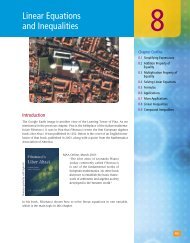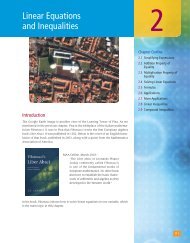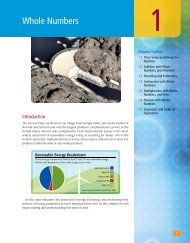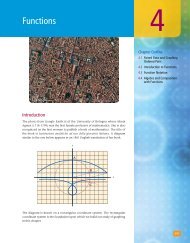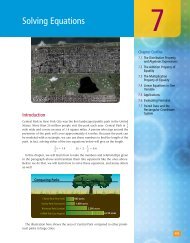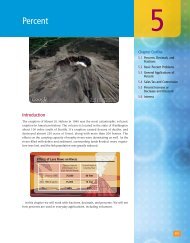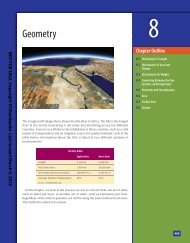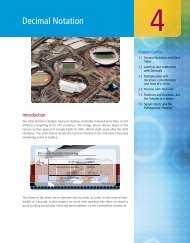Chapter 9 - XYZ Custom Plus
Chapter 9 - XYZ Custom Plus
Chapter 9 - XYZ Custom Plus
Create successful ePaper yourself
Turn your PDF publications into a flip-book with our unique Google optimized e-Paper software.
9.6 Evaluating Formulas<br />
561<br />
The rate equation has two equivalent forms, one of which is obtained by solving<br />
for r, while the other is obtained by solving for t. Here they are:<br />
r 5 d } t<br />
and t 5 d } r<br />
The rate in this equation is also referred to as average speed.<br />
Example 5<br />
At 1 p.m., Jordan leaves her house and drives at an average<br />
speed of 50 miles per hour to her sister’s house. She arrives at 4 p.m.<br />
Solution<br />
a. How many hours was the drive to her sister’s house?<br />
b. How many miles from her sister does Jordan live?<br />
a. If she left at 1:00 p.m. and arrived at 4:00 p.m., we simply subtract<br />
1 from 4 for an answer of 3 hours.<br />
b. We are asked to find a distance in miles given a rate of 50 miles<br />
per hour and a time of 3 hours. We will use the rate equation,<br />
d 5 r ? t, to solve this. We have:<br />
5. At 9 a.m. Maggie leaves her<br />
house and drives at an average<br />
speed of 60 miles per hour to<br />
her sister’s house. She arrives<br />
at 11 a.m.<br />
b. How many hours was the<br />
drive to her sister’s house?<br />
c. How many miles from her<br />
sister does Maggie live?<br />
d 5 50 miles per hour ? 3 hours<br />
d 5 50(3)<br />
d 5 150 miles<br />
Notice that we were asked to find a distance in miles, so our answer has a unit of<br />
miles. When we are asked to find a time, our answer will include a unit of time,<br />
like days, hours, minutes, or seconds.<br />
When we are asked to find a rate, our answer will include units of rate, like<br />
miles per hour, feet per second, problems per minute, and so on.<br />
facts from geometry<br />
Earlier we defined complementary angles as angles that add to 90°. That is, if<br />
x and y are complementary angles, then<br />
x 1 y 5 90°<br />
If we solve this formula for y, we obtain a formula equivalent to our original<br />
formula:<br />
90˚−x<br />
x<br />
Complementary angles<br />
y 5 90° 2 x<br />
Because y is the complement of x, we can generalize by saying that the complement<br />
of angle x is the angle 90° 2 x. By a similar reasoning process, we<br />
can say that the supplement of angle x is the angle 180° 2 x. To summarize,<br />
if x is an angle, then<br />
180˚−x<br />
x<br />
the complement of x is 90° 2 x, and<br />
the supplement of x is 180° 2 x<br />
Supplementary angles<br />
If you go on to take a trigonometry class, you will see these formulas again.<br />
Answer<br />
5. a. 2 hours b. 120 miles



